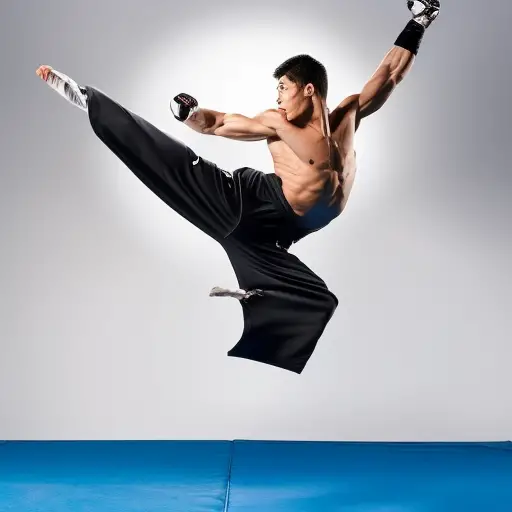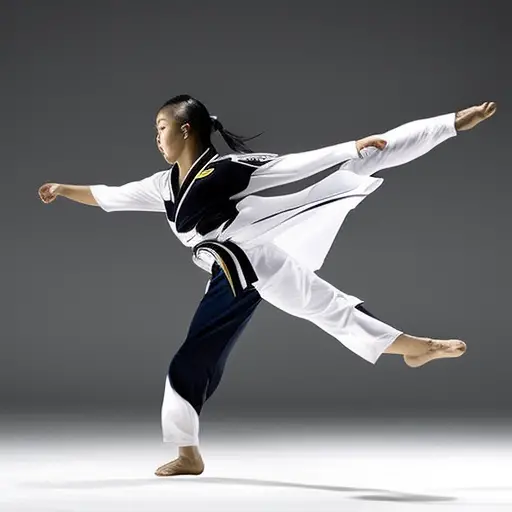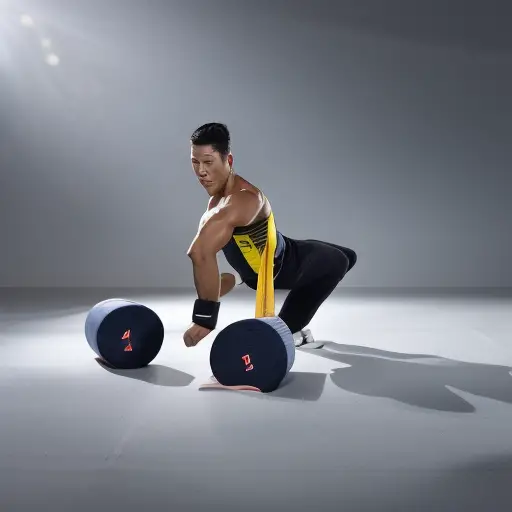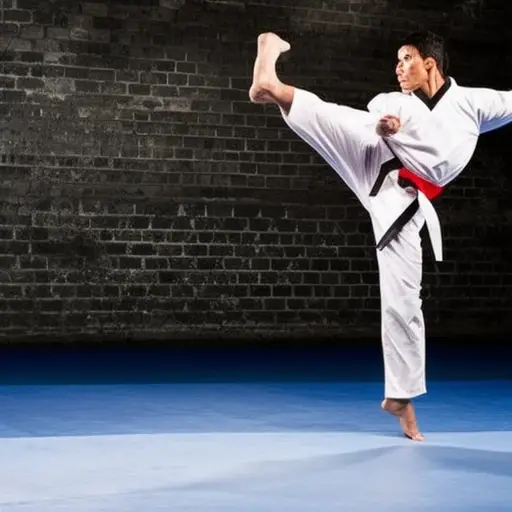Jumping and Spinning Kicks in Taekwondo
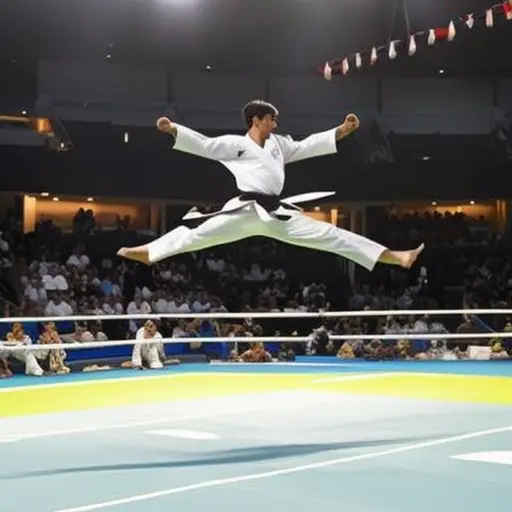
Looking to take your taekwondo skills to new heights? Imagine effortlessly soaring through the air, executing powerful and acrobatic kicks that leave your opponents in awe.
In this article, we delve into the world of jumping and spinning kicks in taekwondo. From the explosive Flying Side Kick to the agile Spinning Hook Kick, we explore the techniques, benefits, and applications of these dynamic moves.
Get ready to elevate your taekwondo game with these awe-inspiring kicks.
The Flying Side Kick: A Powerful Aerial Strike
One of the most effective and versatile aerial strikes in Taekwondo is the flying side kick, which can deliver a devastating blow to an opponent. This technique requires a combination of power, speed, and precision.
To execute a successful flying side kick, practitioners must enhance their flexibility and improve their kicking speed.
Flexibility plays a crucial role in performing the flying side kick effectively. The higher the leg can be lifted, the more powerful the strike will be. Regular stretching exercises, such as splits and hip openers, can help increase the range of motion in the hip and leg muscles. This enhanced flexibility allows practitioners to lift their legs higher and execute the kick with more force.
In addition to flexibility, improving kicking speed is essential for a powerful flying side kick. Rapid leg extension is crucial to surprise opponents and ensure a successful strike. Practitioners can enhance their kicking speed through specific training drills that focus on quickening the leg extension process. These drills include shadowboxing, kicking pads or targets, and practicing the kick in combination with other techniques.
Mastering the 360-degree Roundhouse Kick
When mastering the 360-degree roundhouse kick in Taekwondo, there are several key points to focus on.
Firstly, it is important to maintain proper technique and alignment throughout the kick, ensuring that all movements are precise and controlled.
Secondly, developing balance and power is crucial to execute this kick effectively, as it requires a combination of strength and agility.
Lastly, it is essential to be aware of common mistakes to avoid, such as overextending or telegraphing the kick, which can leave one vulnerable to counterattacks.
Proper Technique and Alignment
Achieving optimal balance and control is crucial for executing the 360-degree roundhouse kick with proper technique and alignment in Taekwondo. To improve flexibility and strengthen core muscles, practitioners can incorporate the following strategies:
-
Regular stretching exercises: Stretching the hip flexors, hamstrings, and quadriceps can help increase the range of motion required for the kick.
-
Core strengthening exercises: Engaging in exercises such as planks, Russian twists, and bicycle crunches can help develop a strong and stable core, which is essential for maintaining control during the kick.
-
Practice with a partner or a target: By repeatedly executing the kick with a target, practitioners can enhance their accuracy, speed, and control.
Developing Balance and Power
To enhance balance and power in executing the 360-degree roundhouse kick, practitioners must diligently focus on developing a strong and stable foundation through targeted exercises and training techniques. Developing flexibility and improving coordination are crucial aspects of achieving this goal. By incorporating specific exercises into their training regimen, practitioners can increase their range of motion and enhance their overall balance and stability.
One effective exercise for developing flexibility is the butterfly stretch, which targets the hip muscles and improves the range of motion in the legs. Additionally, practicing dynamic kicks and drills that involve changing directions and heights will help improve coordination and agility.
Another important aspect of developing balance and power is strengthening the core muscles. This can be achieved through exercises such as planks, Russian twists, and medicine ball rotations.
By implementing these exercises and techniques into their training routine, practitioners can enhance their balance and power, ultimately leading to more precise and powerful 360-degree roundhouse kicks.
In the next section, we will discuss common mistakes to avoid when executing jumping and spinning kicks.
Common Mistakes to Avoid
One common mistake that practitioners should avoid when mastering the 360-degree roundhouse kick is rushing the execution without proper technique and control. This can lead to a lack of power and accuracy, diminishing the effectiveness of the kick.
To help practitioners avoid this mistake and improve their technique, here are some tips and tricks to keep in mind:
- Focus on proper body alignment throughout the kick, ensuring that the hips, shoulders, and kicking leg are all aligned in the direction of the target.
- Practice the kick in a slow and controlled manner, gradually increasing speed and power as proficiency improves.
- Develop flexibility in the hip and groin area to achieve a higher and more powerful kick.
By paying attention to these common mistakes and implementing these tips and tricks, practitioners can effectively master the 360-degree roundhouse kick.
Now, let’s explore the dynamic jumping front kick.
Exploring the Dynamic Jumping Front Kick
The execution of the dynamic jumping front kick requires precise timing and controlled power. This advanced technique in Taekwondo involves propelling oneself off the ground while simultaneously delivering a front kick to the target. To master this move, practitioners must explore different variations of the jumping front kick and engage in specific training exercises that enhance their jumping kicks.
One variation of the jumping front kick is the double leg jumping front kick. In this technique, both legs are used to generate power, resulting in a more forceful kick. Another variation is the switch jumping front kick, where the lead leg switches with the rear leg mid-air, allowing for swift and unexpected attacks.
To improve jumping kicks, practitioners can incorporate various training exercises into their practice routine. Plyometric exercises, such as box jumps and depth jumps, help develop explosive power in the legs. Additionally, practicing jumping front kicks on a trampoline or soft surface can enhance balance, coordination, and overall jumping ability.
It is crucial to note that mastering the dynamic jumping front kick requires patience, consistency, and proper technique. Practitioners should gradually increase the intensity and height of their jumps to avoid injuries. With dedicated training and persistent practice, the dynamic jumping front kick can become a formidable weapon in a Taekwondo practitioner’s arsenal.
Unleashing the Devastating Jumping Back Kick
An effective technique in Taekwondo, the jumping back kick delivers a powerful strike while swiftly retreating from the opponent. This move requires developing proper technique to maximize power and impact. Here are three key points to consider when executing the jumping back kick:
-
Body Positioning: To perform a successful jumping back kick, it is crucial to have a solid foundation. Start by assuming a fighting stance with your rear foot slightly behind the front foot. As you jump backward, maintain a low and balanced position, keeping your knees slightly bent and your core engaged.
-
Timing and Distance: Timing is key in executing the jumping back kick effectively. It is important to gauge the distance correctly to ensure that you can strike your opponent with maximum impact. Practice the timing of your jump and kick to synchronize your movements seamlessly.
-
Hip Rotation and Extension: The power of the jumping back kick lies in the rotation and extension of the hips. As you jump backward, rotate your hips in the opposite direction of your kick. This rotation generates the momentum needed to deliver a powerful strike. At the same time, extend your kicking leg with a snapping motion, aiming to strike your opponent’s target area.
By mastering these elements and consistently practicing the jumping back kick, you can unleash a devastating strike while maintaining distance from your opponent.
Transitioning to the subsequent section, let’s now explore the spinning hook kick: an acrobatic and effective move.
The Spinning Hook Kick: An Acrobatic and Effective Move
How does the spinning hook kick showcase both acrobatic skill and effectiveness in Taekwondo?
The spinning hook kick is a remarkable move in Taekwondo that combines acrobatic finesse with devastating effectiveness. This kick involves a spinning motion, where the practitioner rotates their body and extends their leg in a hooking motion to strike their opponent.
One of the acrobatic effects of the spinning hook kick is the visual spectacle it creates. As the practitioner spins in the air, their body seems to defy gravity, showcasing their agility and balance. The fluidity of the movement, combined with the power generated from the rotation, makes the spinning hook kick a breathtaking display of acrobatic skill.
In addition to its acrobatic appeal, the spinning hook kick is also highly effective in combat. When executed correctly, it can deliver a powerful strike to the opponent’s head or body. The spinning motion generates rotational force, allowing the practitioner to generate significant power behind the kick. The hooking motion of the leg allows for a wider striking range, making it difficult for the opponent to anticipate or defend against.
Breaking Barriers With the Jumping Axe Kick
The jumping axe kick is a dynamic move in Taekwondo that involves leaping into the air and delivering a downward strike with the heel of the foot. This technique is highly regarded for its ability to break barriers and push the boundaries of what is possible in martial arts.
One of the reasons why the jumping axe kick is considered powerful is its combination of height and speed. By launching into the air, practitioners can strike targets that are higher and faster than with regular kicks. This allows them to overcome physical barriers and deliver devastating blows to their opponents.
In addition to its physical demands, the jumping axe kick also requires a strong sense of balance and coordination. Executing this technique effectively necessitates precise timing and control, encouraging practitioners to improve their overall technique. This focus on balance and coordination not only enhances the power of the kick but also develops essential skills that can be applied to other aspects of Taekwondo.
Furthermore, the jumping axe kick can surprise opponents and catch them off guard. Its aerial nature makes it less predictable and more difficult to defend against. By breaking through their defenses, practitioners can gain a significant advantage in combat.
Enhancing Agility With the Jumping Crescent Kick
Executing the jumping crescent kick in Taekwondo requires precise footwork and dynamic movements that enhance agility and fluidity in practitioners. This advanced technique not only showcases the practitioner’s athleticism but also serves as a means to enhance their overall performance in Taekwondo.
One key benefit of the jumping crescent kick is its ability to enhance speed. By utilizing explosive power and proper technique, practitioners can execute this kick with lightning-fast speed, catching opponents off guard and increasing their chances of landing a successful strike. The combination of precise footwork and the momentum generated from the jump allows for a quick and efficient execution of the kick, making it a valuable tool in competitive sparring and self-defense scenarios.
Furthermore, the jumping crescent kick also aids in increasing flexibility. The execution of this kick requires a high degree of flexibility in the hip and leg muscles, as well as the ability to maintain balance throughout the movement. By regularly practicing this kick, practitioners can improve their range of motion, allowing for more fluid and controlled movements in other techniques as well. Increasing flexibility not only helps prevent injuries but also enables practitioners to execute various kicks and movements more effectively.
Unleashing the Power of the Jumping Reverse Turning Kick
The jumping reverse turning kick is a powerful aerial attack technique in Taekwondo that requires precision and mastery to execute effectively. This kick involves jumping off the ground, rotating the body in mid-air, and delivering a forceful kick with the heel or ball of the foot.
Effective Aerial Attack Techniques
An integral aspect of mastering aerial attack techniques in Taekwondo is understanding the precise timing and explosive power required to execute the jumping reverse turning kick effectively. This advanced kick combines the agility and strength of a jump with the precision and speed of a spinning kick, making it a formidable weapon in the arsenal of any Taekwondo practitioner.
To develop aerial attack strategies and train for aerial kicks, practitioners must focus on the following key elements:
-
Perfecting the takeoff: Proper jumping technique and timing are crucial to generate the necessary height and momentum for the kick.
-
Engaging the core: A strong core is essential for stability and control during the aerial kick, allowing the practitioner to maintain balance and execute precise movements.
-
Targeting accuracy: Precise aim and timing are vital to ensure the kick lands on the intended target with maximum impact.
Mastering these aspects of effective aerial attack techniques sets the foundation for the subsequent section on mastering jumping kick precision.
Mastering Jumping Kick Precision
To achieve mastery in jumping kick precision, practitioners must strive for impeccable accuracy and timing in executing the powerful jumping reverse turning kick. This technique requires a combination of skill, strength, and practice to perfect.
Mastering jump kicks involves improving both the height and distance of the kick. Height can be enhanced by focusing on leg strength and flexibility through specific training exercises. Practitioners can also improve their jumping kick height by engaging in plyometric exercises to increase explosive power. Additionally, proper body positioning and weight distribution play a crucial role in achieving greater height.
In terms of distance, practitioners must work on the speed and momentum generated during the jump. This can be achieved through regular practice and refining the technique to maximize power and distance.
Frequently Asked Questions
What Are Some Common Mistakes to Avoid When Executing a Jumping and Spinning Kick in Taekwondo?
When executing jumping and spinning kicks in Taekwondo, it is important to be aware of common mistakes to avoid. By focusing on proper technique, balance, and timing, practitioners can enhance their training techniques and minimize errors.
How Can I Improve My Balance and Control While Performing Jumping and Spinning Kicks?
Improving balance and control while performing jumping and spinning kicks requires a combination of techniques and tips. By focusing on core strength, practicing proper form, and gradually increasing difficulty, one can enhance their stability and precision in these advanced taekwondo maneuvers.
Are There Any Specific Conditioning Exercises That Can Help Me Strengthen the Muscles Needed for These Kicks?
There are several effective conditioning exercises that can help strengthen the muscles needed for jumping and spinning kicks. These exercises focus on building lower body strength, flexibility, and balance to enhance performance and prevent injuries.
What Are Some Effective Strategies for Incorporating Jumping and Spinning Kicks Into Sparring or Self-Defense Situations?
When incorporating jumping and spinning kicks into taekwondo sparring or self-defense situations, it is important to utilize effective techniques that generate power and speed. This requires proper training and mastering of the necessary skills.
Can These Advanced Kicks Be Modified or Adapted for Practitioners With Limited Flexibility or Physical Abilities?
Modified kicks and alternative techniques can be adapted for practitioners with limited flexibility or physical abilities. By making adjustments to the height, speed, or complexity of the kicks, individuals can still incorporate effective techniques into their sparring or self-defense situations.
Conclusion
In conclusion, mastering the jumping and spinning kicks in taekwondo requires discipline, precision, and agility. These powerful aerial strikes not only demonstrate the practitioner’s skill, but also showcase the artistry and athleticism of taekwondo.
By incorporating these dynamic moves into their repertoire, practitioners can break barriers and unleash their full potential in the martial art. As the saying goes, ‘With every jump and spin, a taekwondo practitioner reaches new heights, both physically and mentally.’


